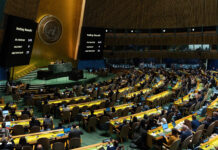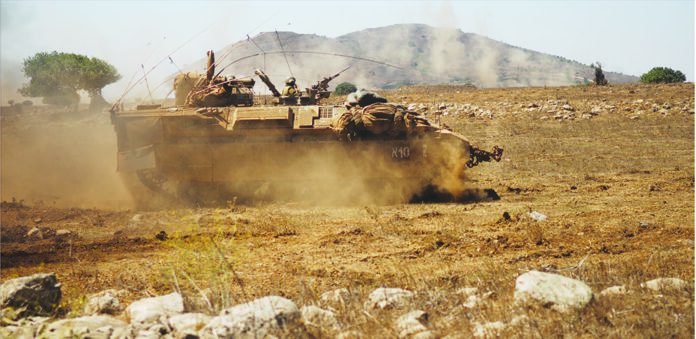In the past three weeks, there has been a significant increase in attacks on international coalition bases in northeastern Syria. These attacks are carried out by militias supported by Iran, operating in both Iraq and Syria. There are reports suggesting the establishment of centres to coordinate these strikes. The goal seems to be exploiting the discontent with the USA and Israel, aiming to expand Iranian influence in Syria.
This tension coincides with the ongoing conflict in Gaza between Israel and Palestinian factions, particularly Hamas. In the last two weeks, there have been frequent assaults on American forces’ bases in eastern Syria. These attacks target various locations, including the al-Omar Field, Conoco plant bases, Kharab al-Jir base, Tal Beydar, al-Shaddadi, and the al-Tanf base near the Syria-Iraq-Jordan border. The attacks involve different methods, such as drone strikes, improvised missiles, and mortar shells. Similar activities have also been reported in Iraq, with threats of further escalation.
The US military conducted airstrikes against Iranian militias in Deir ez-Zor on October 26, and November 9, and precision strikes on November 12 in Abu Kamal and al-Mayadin. The Pentagon states that these actions are in self-defence to protect US forces and not intended to escalate the conflict. Groups claiming responsibility for the attacks on American forces in Syria identify themselves as “The Islamic Resistance in Iraq.”
This choice of name, similar to Lebanese Hezbollah’s designation, appears to avoid implicating specific Iraqi or Syrian factions, preventing political pressure on their governments. A meeting in al-Bukamal aimed at coordinating the activities of the Islamic Resistance in Iraq involved various militia factions, including Popular Mobilization Forces in Iraq, Fatemiyoun and Zainabiyoun militias, Lebanese Hezbollah, the 47th Regiment, Saraya al-Khorasani, and local factions.
The operations centre coordinates activities along three strategic axes involving missile and drone strikes, focusing on coalition bases, particularly in the eastern bank of the Euphrates River and the al-Tanf base. Elite forces trained in Dimas Camp near Damascus and training camps near al-Mayadin city carry out these operations. The goal is a calculated escalation against American bases, coordinating attacks effectively while avoiding substantial US retaliation. The strategy resembles Hezbollah’s approach in southern Lebanon against Israel. The threat of further escalation depends on the international coalition forces’ response to current attacks and leverages American reluctance to widen the conflict.
The coalition’s long silence on the issue of Iranian reinforcements, along with Washington ignoring Tehran’s efforts to expand its influence in the eastern Euphrates region, has brought us to a critical point. It might be too late to change things now, and there’s a risk that the region could become a hotspot for an international conflict, with the local population caught in the middle.
In recent months, more weapons have been brought into the Qamishli countryside and al-Hasakah city. Every week, supplies arrive from Damascus to Qamishli Airport using Ilyushin aircraft. This is part of a plan to strengthen the military forces in Qamishli and the surrounding areas. The shipments mostly include accurate sniper rifles, night vision gear, small drones, explosive devices, medium-sized machine guns, and mortar guns.
Local groups are also getting intensive training, and some are sent to Damascus and Deir ez-Zor. Additionally, members of the Saraya al-Khorasani militia have been moving to the Deir ez-Zor countryside, and security units are now near al-Shaddadi and Tal Hamis, keeping an eye on coalition forces at the al-Shaddadi and Kharab al-Jir bases in the al-Hasakah countryside.
The recent increase in Iranian actions was expected. Reports from the Middle East Institute last year talked about Iran’s efforts to strengthen its influence in eastern Syria. This involves plans to target international coalition bases by using “popular resistance” and security operations against American forces. The goal is to make them leave and create more room for Iranian presence.
The Saraya al-Khorasani militia, connected to the IRGC and active in al-Hasakah city, and Hezbollah’s Task Force militia in the southern countryside of Qamishli, are crucial to these efforts. Iran is also trying to gain support by supporting Arab tribal leaders, tapping into tribal dissatisfaction with the Syrian Democratic Forces’ actions and the coalition’s seeming indifference.
Recent events suggest that Iran, through its proxies in eastern Syria, is getting ready to keep attacking international coalition bases. They seem to be choosing the right times to make more impactful attacks causing significant losses. This strategy might take advantage of the coalition’s slow response to these attacks.
According to sources, these militias might be preparing for larger attacks from areas controlled by the Syrian Democratic Forces (SDF), near the American bases. This escalation is dangerous, putting both coalition forces and local people at risk. As these militias try to turn the local population against American forces, linking them to the Israeli offensive in Gaza, they create a widespread sense of popular resistance. This growing resistance might force coalition forces to think about leaving the region or staying within their bases. If this happens, it could give Iranian-backed militias the chance to make the region less secure and increase their influence, to the disadvantage of the SDF.
The coalition’s long silence on the issue of Iranian reinforcements, along with Washington ignoring Tehran’s efforts to expand its influence in the eastern Euphrates region, has brought us to a critical point. It might be too late to change things now, and there’s a risk that the region could become a hotspot for an international conflict, with the local population caught in the middle.
Through recent actions, Iran is trying to show the extent of its influence and its control over operations from southern Lebanon through eastern Syria to Iraq and even reaching the Houthis in Yemen. This strategic positioning could give Iran an advantage in any future political negotiations, making it the main beneficiary of the ongoing troubles in the region, to the detriment of the local people.






















